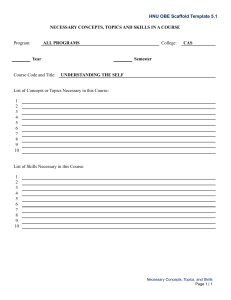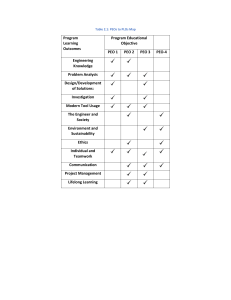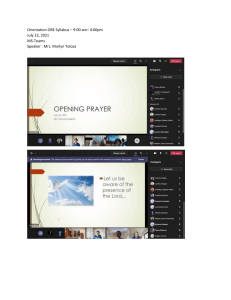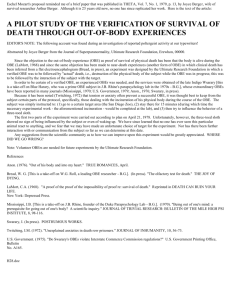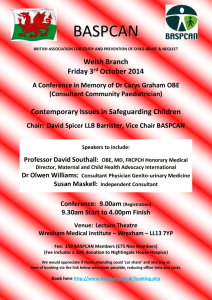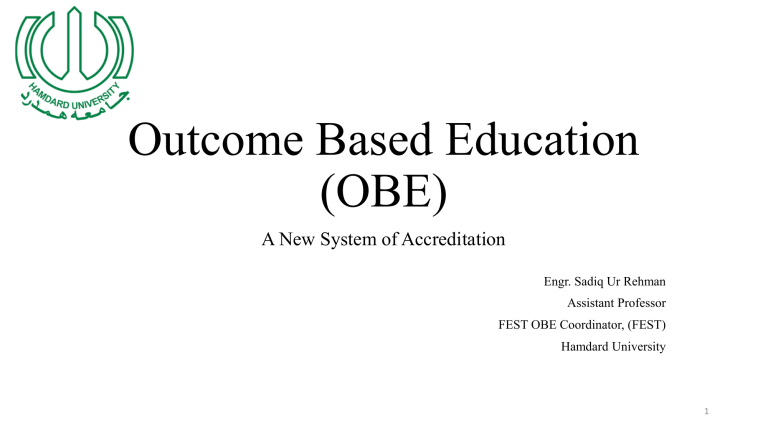
Outcome Based Education (OBE) A New System of Accreditation Engr. Sadiq Ur Rehman Assistant Professor FEST OBE Coordinator, (FEST) Hamdard University 1 Outline of Presentation • Bloom’s Taxonomy • Outcome Based Education (OBE) • Different Levels of Outcomes • OBE at FEST • FEST’s Vision and Mission • Program Educational Objectives (PEOs) • Program Learning Outcomes (PLOs) • • • • • • Course Learning Outcomes (CLOs) OBE Assessment Sheet Depth of Knowledge Open-Ended Labs Learning Outcome Assessment Key Performance Indicator for CLOs and PLOs Attainment • Rubrics • OBE Student Dashboard for FEST students 2 Benjamin Samuel Bloom 3 Bloom’s Taxonomy • This taxonomy of learning behaviors may be thought of as “the goals of the learning process.” • After a learning episode, the learner should have acquired a new skill, knowledge and attitude. • Set of three hierarchical models used to classify educational learning objectives into levels of complexity and specificity. • The three lists cover the learning objectives in cognitive, affective and sensory domains. 4 Domains 1. Cognitive Domain 2. Affective Domain 3. Psychomotor Domain Skills in the cognitive domain revolve around knowledge, comprehension, and critical thinking on a particular topic Skills in the affective domain describe the way people react emotionally (attitude) and their ability to feel other living things' pain or joy. Skills in the psychomotor domain describe the ability to physically manipulate a tool or instrument like a hand or a hammer (i.e Skill based). 5 Cognitive Domain 6 Psychomotor Domain 7 Affective Domain 8 International Engineering Alliance (IEA) 9 Washington Accord Full Signatory Countries Australia South Africa Canada Sri Lanka China Turkey Chinese Taipei India - Represented by National Board of Accreditation (NBA) (2014) Hong Kong China Ireland Japan Korea Malaysia New Zealand Russia Singapore Pakistan - Represented by Pakistan Engineering Council (PEC) (2017) Peru (2018) United States - Represented by Accreditation Board for Engineering and Technology (ABET) (1989) United Kingdom Represented by Engineering Council United Kingdom (ECUK) (1989) 10 Employers Rating of Skills/Qualities – 2002 1. 2. 3. 4. 5. 6. 7. 8. 9. 10. 11. 12. 13. 14. 15. 16. 17. 18. 19. 20. Communication (verbal & written) Honesty/Integrity Teamwork skills Interpersonal skills Strong work ethics Motivation & initiative Flexibility/adaptability Analytical skills Computer skills Organisational skills Detail oriented Leadership skills Self confidence Friendly/outgoing personality Well mannered / polite Tactfulness GPA (3.0 or better) Creativity Sense of humour Entrepreneurial skills/risk taker 4.69 4.59 4.54 4.50 4.46 4.42 4.41 4.36 4.21 4.05 4.00 3.97 3.95 3.85 3.82 3.75 3.68 3.59 3.25 3.23 11 Graduate Attributes • The program must demonstrate that by the time of graduation the students have attained a certain set of knowledge, skills and behavioral traits, at-least to some acceptable minimum level. • It is to be demonstrated that the students have acquired the following graduate attributes. 12 Graduate Attributes • Engineering Knowledge • Problem Analysis • Design/Development of Solutions • Investigation • Modern Tool Usage • The Engineer and Society • Environment and Sustainability • Ethics • Individual and Team Work • Communication • Project Management • Lifelong Learning 13 Outcome Based Education (OBE) • OBE is not a separate degree program • OBE is a process that involves assessment and evaluation practices in education to reflect the attainment of expected learning and showing expertise in the program area • OBE is educational process that focuses on what students can do or the qualities they should develop after they are taught 14 What it means for you • If you program is accredited on Outcome based Education (OBE) system of the International Engineering Alliance (IEA) • You can easily go and study or work in any of the signatory countries • You don’t need to clear any competitive or equivalence examination 15 OBE Benefits to students • Clarity= Students will know what is expected from them Teacher will know what they need to teach in course • Flexibility= Teacher will guide and help student to understand the material in various ways • Involvement= students are expected to do thing from their own to gain full understanding. • Employment Opportunities= freedom to work in signatory country with out equivalency exam 16 Key terms for Outcome Based Education (OBE) 17 Different Levels of Outcomes Programme Educational Objectives Few years after Graduation – 4 to 5 years Programme Outcomes Course/subject Outcomes Weekly/Topic Outcomes Upon graduation Upon subject completion Upon weekly/topic completion 18 Advantage of OBE system • OBE emphasizes the achievement of student outcomes and thus improves the quality of education and will bring it at par with international standards. • Go and study or work in any of the signatory countries with out clear any competitive or equivalence examination 19 OBE at FEST • Working start in year 2015 • With the continuous hard efforts of OBE team at FEST • Program of EE, EP, CSE and BME is OBE accredited • PEC visit is expected in Aug 2021 for EE, EEP and ME. • We are having OBE professional in our faculty • Not only trained us but also provides training to other institutes. 20 OBE System at FEST 21 FEST’s Vision and Mission • FEST’s Vision: • To be a world-class institution of learning and applied research in Engineering, Sciences and Technologies. • FEST’s Mission: • To advance and create knowledge in Engineering Sciences and Technology. • To encourage well-rounded imbibed personalities, creative and entrepreneurial minds; sensitive towards social responsibility and moral values. • To provide innovative solutions to local and global problems 22 Program Educational Objectives (PEOs) • Program outcomes are the narrower statements that describe what students are expected to know and be able to do by the time of graduation. • These relate to the knowledge, skills and attitude that the students acquire while progressing through the program. • The program must demonstrate that by the time of graduation the students have attained a certain set of knowledge, skills and behavioral traits, at-least to some acceptable minimum level 23 Program Educational Objectives (PEOs) 24 Flowchart of CQI Process involved in improvement of PEOs 25 Characteristics of Good PEOs Statements • Each addresses one or more needs of one or more stakeholders • Consistent with the mission & vision of the institution • Number of statements should be limited and manageable • Should not be simply restatement of outcomes 26 Program Educational Objectives (PEOs) PEO_1 Take an interdisciplinary and integrative approach to address and solve engineering issues in broad societal contexts PEO_2 Have the intellectual independence and leadership skills to critically evaluate information and to take creative course of action PEO_3 Practice the habits of lifelong learning, necessary for a good human being and a sound professional 27 Process of using PEO’s attainment result for CQI of program 28 Process for PEO's attainment 29 Employer feedback mechanism and its usage for PEO refinement 30 CQI Procedure for a year 31 General procedure of CQI 32 Program Learning Outcomes (PLOs) • Students become exam oriented or CGPA driven. • Exam Result is not the Most Important Consideration by Employer • Graduates lack of emphasis on skills needed in jobs • Communication skills, interpersonal skills, analytical skills, working attitude etc. • PLOs describe what students will know and able to do at the time of graduation • There are 12 PLOs mandatory to be achieved by the student for awarding of degree. 33 Continual Quality Improvement Mechanism for Program Learning Outcomes 34 Program Learning Outcomes (PLOs) Engineering Attributes PLO_1 PLO_2 PLO_3 PLO_4 PLO_5 PLO_6 Engineering Knowledge: An ability to apply knowledge of mathematics, science, engineering fundamentals and an engineering specialization to the solution of complex engineering problems. Problem Analysis: An ability to identify, formulate, research literature, and analyze complex engineering problems reaching substantiated conclusions using first principles of mathematics, natural sciences and engineering sciences. Design/Development of Solutions: An ability to design solutions for complex engineering problems and design systems, components or processes that meet specified needs with appropriate consideration for public health and safety, cultural, societal, and environmental considerations. Investigation: An ability to investigate complex engineering problems in a methodical way including literature survey, design and conduct of experiments, analysis and interpretation of experimental data, and synthesis of information to derive valid conclusions. Modern Tool Usage: An ability to create, select and apply appropriate techniques, resources, and modern engineering and IT tools, including prediction and modeling, to complex engineering activities, with an understanding of the limitations. The Engineer and Society: An ability to apply reasoning informed by contextual knowledge to assess societal, health, safety, legal and cultural issues and the consequent responsibilities relevant to professional engineering practice and solution to complex engineering problems. 35 Program Learning Outcomes (PLOs) Engineering Attributes Environment and Sustainability: An ability to understand the impact of professional engineering PLO_7 solutions in societal and environmental contexts and demonstrate knowledge of and need for sustainable development. Ethics: Apply ethical principles and commit to professional ethics and responsibilities and norms of PLO_8 engineering practice. Individual and Team Work: An ability to work effectively, as an individual or in a team, on PLO_9 multifaceted and /or multidisciplinary settings. Communication: An ability to communicate effectively, orally as well as in writing, on complex engineering activities with the engineering community and with society at large, such as being able to PLO_10 comprehend and write effective reports and design documentation, make effective presentations, and give and receive clear instructions. Project Management: An ability to demonstrate management skills and apply engineering principles to PLO_11 one’s own work, as a member and/or leader in a team, to manage projects in a multidisciplinary environment. Lifelong Learning: An ability to recognize importance of, and pursue lifelong learning in the broader PLO_12 context of innovation and technological developments. 36 Mapping of PLOs with PEOs S. No. 1 2 3 4 5 6 7 8 9 10 11 12 PLOs Engineering Knowledge Problem Analysis Design/Development of Solutions Investigation Modern Tool Usage The Engineer and Society Environment and Sustainability Ethics Individual and Team Work Communication Project Management Lifelong Learning PEO_1 ✓ ✓ ✓ ✓ ✓ PEOs PEO_2 PEO_3 ✓ ✓ ✓ ✓ ✓ ✓ ✓ 37 Course Learning Outcomes (CLOs) • Expected CLOs are derived and Mapped with PLOs • CLOs from all the course in program leads to achievement of PLOs 38 Mapping of CLOs and PLOs (example SnS) 39 CLOs Assessment Mechanism (example SnS) 40 OBE Assessment Sheet (example Signal and Systems) 41 Depth of Knowledge • Complex Engineering Problems (CEP) and Open Ended Problems are part of evaluation OBE system to develop and evaluate critical thinking in a student. • Complex engineering problems are provided to students on individual or group basis in some subjects of the curriculum. These problems are intended to develop analytical, logical and research skills of the students. These tasks provide opportunity to student to achieve the desirable tasks with their learned skills. • The scenarios of the problem do not bound the students to stick strictly to that subject rather they have to blend the acquired knowledge, on hands skills and research tools to achieve the desired task. 42 Open-Ended Labs • An open-ended lab is where students are given the freedom to develop their own experiments, instead of merely following the already set guidelines from a lab manual or elsewhere. • Making labs open-ended pushes students to think for themselves and think harder. • The students here have to devise their own strategies and back them with explanations, theory and logical justification. • This not only encourages students to come up with their experiments, but requires them to defend themselves and their experiment, if questioned. 43 Learning Outcome Assessment • The program must ensure that each student has achieved all PLOs to acceptable level through assessment of CLOs. • The appropriateness of the assessment methods along with the level of achievement against the targeted outcomes must be evaluated. • Mapping of program outcomes to individual courses, nature of assessment tools (direct/ indirect/rubrics) and the process of evaluation to determine the attainment of PLOs should be demonstrated to the students. 44 Key Performance Indicator for CLOs and PLOs Attainment • Every student of the department needs to fulfil the achievement criteria defined to qualify for the next semester. The passing criteria for successful CLO and PLO completion is 50% and on cohort level, KPI is 60%. • If any student fails to attain any CLOs or PLOs as per KPI (50%) then he/she is required to follow the measures and steps as per university policy • If the KPI of indirect measurement does not meet the set criteria, recommendations will be prepared by the OBE committee for improving the weak graduate attributes. 45 Rubrics • A set of instructions or rules. • Rubrics based assignment & complex problems will be given to each student. • Laboratory work will be assessed through rubrics • FYP and Report work will also be assessed through rubrics • Semester Project Rubrics, FYP RUBRICS_FirstEvaluation, FYP RUBRICS_FinalEvaluation and FYP RUBRICS_ReportEvaluation 46 OBE Student Dashboard for FEST students • Student of FEST can monitor they PLO progress by using their portal. • Details can be obtain on portal under the option of “Unofficial OBE Transcript” • PLO Attainment details can be seen as a summery, semester wise and subject wise 47 OBE Student Dashboard for FEST students 48 What are expected from students under OBE • Expectation from students • • • • Ready to demonstrate what they know Accepting responsibility what they don’t know Continue achieving high performance Accomplish all 12 PLOs. • Ensuring attainment of outcomes through assessments 49 Thank you for listing…. 50 QnA 51
